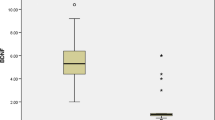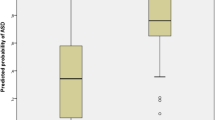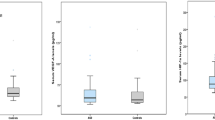Abstract
S tem cell factor (SCF) and its receptor (c-kit) signaling play important role in normal brain physiology including neurogenesis, synapse formation and spatial learning function of the hippocampal region of the brain. Autism spectrum disorder (ASD) is believed to result from abnormal development of neuronal networks and synaptic function. The aim of this study was to evaluate the SCF and its soluble receptor (s-ckit) serum concentrations in ASD. We also studied the serum SCF and s-ckit concentration with the severity of ASD (Levels 1-3; Mild, Moderate and severe, respectively). Ninety five patients with ASD (Mild; n=33, Moderate; n=32 and severe; n=30) and 82 normal controls age matched were included in this study. The serum concentration of SCF and s-ckit were measured by enzyme-linked immunosorbent assay (ELISA). The SCF serum concentration in control subjects was 3.45±1.06 ng/ml and in ASD was 3.41±0.92 ng/ml (P=0.88). The serum levels of s-ckit in control and ASD groups were 56.82±13.22 ng/ml and 67.11±12.00, respectively (P=001). We have also studied serum SCF and s-ckit concentrations with the severity of ASD. The serum concentration of SCF in mild, moderate and severe ASD groups was 3.45±0.93, 3.4±0.87 and 3.43±0.98 ng/ml, respectively (P>0.05) and for s-ckit was 48.77±9.28, 61.66±12.18 and 93.11±14.81ng/ml, respectively (P<0.05). The result of this study suggests that serum s-cKit concentrations may provide a reliable and practical indicator of ASD and positively correlated with disease severity. It is also concluded that s-cKit might be involved in the pathophysiology of ASD.




Similar content being viewed by others
Data availability
A submission to the journal of Metabolic Brain Disease implies that materials described in the manuscript, including all relevant raw data, will be freely available to any researcher wishing to use them for non-commercial purposes, without breaching participant confidentiality.
References
American Psychiatric Association (2013) Diagnostic and Statistical Manual of Mental Disorders: DSM-5, 5 edn. American Psychiatric Association, Washington, DC, p 947
Benvenuto A, Moavero R, Alessandrelli R et al (2009) Syndromic autism: causes and pathogenetic pathways. World J Pediatr 5:169–176
Bowen D, Yancik S, Bennett L et al (1993) Serum stem cell factor concentration in patients with myelodysplastic syndromes. Br J Haematol 85:63–66
Dahlen DD, Lin NL, Liu YC et al (2001) Soluble Kit receptor blocks stem cell factor bioactivity in vitro. Leuk Res 25:413–421
Elsabbagh M, Divan G, Koh YJ et al (2012) Global prevalence of autism and other pervasive developmental disorders. Autism Res 5:160–179
Erlandsson A, Larsson J, Forsberg-Nilsson K (2004) Stem cell factor is a chemoattractant and a survival factor for CNS stem cells. Exp Cell Res 301:201–210
Hirata T, Morii E, Morimoto M et al (1993) Stem cell factor induces outgrowth of c-kit-positive neurites and supports the survival of c-kit-positive neurons in dorsal root ganglia of mouse embryos. Development 119:49–56
Jin K, Mao XO et al (2002) Stem cell factor stimulates neurogenesis in vitro and in vivo. J Clin Invest 110:311–319
Kalmarzi RN, Foroutan A, Abdi M et al (2019) Serum level of stem cell factor and its soluble receptor in aspirin-exacerbated respiratory disease. Immunotherapy 11:1283–1291
Kasamatsu S, Hachiya A, Higuchi K et al (2008) Production of the soluble form of KIT, s-KIT, abolishes stem cell factor-induced melanogenesis in human melanocytes. J Invest Dermatol 128:1763–1772
Katafuchi T, Li AJ, Hirota S et al (2000) Impairment of spatial learning and hippocampal synaptic potentiation in c-kit mutant rats. Learn Mem 7:383–392
Keshet E, Lyman SD, Williams DE et al (1991) Embryonic RNA expression patterns of the c-kit receptor and its cognate ligand suggest multiple functional roles in mouse development. EMBO J 10:2425–2435
Khalili M, Mashayekhi F, Salehi Z (2020) Association of Hepatocyte Growth Factor (HGF) genetic variation (S3735520) and HGF serum concentration in autism spectrum disorders: a case-control study. Caspian J Neurol Sci 6:3–10
Kim D, Im JO, Won et al (2003) Upregulation of c-Kit receptor and stem cell factor in cerebellar inhibitory synapses in response to kainic acid. J Neurosci Res 1:72–78
Lee Y, Jung J, Cho et al (2013) Increased SCF/c-kit by hypoxia promotes autophagy of human placental chorionic plate-derived mesenchymal stem cells via regulating the phosphorylation of mTOR. J Cell Biochem 114:79–88
Lennartsson J, Rönnstrand L (2012) Stem cell factor receptor/c-Kit: from basic science to clinical implications. Physiol Rev 92:1619–1649
Łukaszewicz-Zając M, Mroczko B et al (2017) Stem cell factor in the serum of patients with esophageal cancer in relation to its histological types. Arch Med Sci 13:1357–1364
Makowska JS, Cieslak M, Kowalski ML (2009) Stem cell factor and its soluble receptor (c-kit) in serum of asthmatic patients- correlation with disease severity. BMC Pulm Med 9:27
Mashayekhi F, Gholizadeh L (2011) Administration of anti-c-kit antibody into the cerebrospinal fluid leads to increased cell death in the developing cerebral cortex. Saudi J Biol Sci 18:261–266
Merkwitz C, Lochhead P, Tsikolia N et al (2011) Expression of KIT in the ovary, and the role of somatic precursor cells. Prog Histochem Cytochem 46:131–184
Mostafa GA, Bjørklund G, Urbina MA et al (2016) The levels of blood mercury and inflammatory-related neuropeptides in the serum are correlated in children with autism spectrum disorder. Metab Brain Dis 31:593–599
Pop B, Niculae A, Pop TL, Răchișan AL (2017) Individuals with autism have higher 8-Iso-PGF2alpha levels than controls, but no correlation with quantitative assay of Paraoxonase 1 serum levels. Metab Brain Dis 32:1943–1950
Quan L, Zhao Y, Yi J, Shi XD, Zhong Y, Liu L (2021) Serum adiponectin levels are reduced in autism spectrum disorder and association with severity of symptoms. Metab Brain Dis 36:491–498
Russo AJ, Krigsman A, Jepson B et al (2009) Decreased serum Hepatocyte Growth Factor (HGF) in autistic children with severe gastrointestinal disease. Biomark Insights 4:181–190
Sacai H, Sakoori K, Konno K et al (2020) Autism spectrum disorder-like behavior caused by reduced excitatory synaptic transmission in pyramidal neurons of mouse prefrontal cortex. Nat Commun 11:5140
Sala C, Vicidomini C, Bigi I et al (2015) Shank synaptic scaffold proteins: keys to understanding the pathogenesis of autism and other synaptic disorders. J Neurochem 135:849–858
Salmassi A, Zorn S, Mettler L et al (2011) Circulating concentration of stem cell factor in serum of stimulated IVF patients. Reprod Biomed Online 22:140–147
Sun L, Lee J, Fine HA (2004) Neuronally expressed stem cell factor induces neural stem cell migration to areas of brain injury. J Clin Invest 113:1364–1374
Tajima F, Tsuchiya H, Nishikawa K et al (2010) Hepatocyte growth factor mobilizes and recruits hematopoietic progenitor cells into liver through a stem cell factor-mediated mechanism. Hepatol Res 40:711–719
Tayel SI, El-Hefnway SM, Abd E (2017) Association of stem cell factor gene expression with severity and atopic state in patients with bronchial asthma. Respir Res 18:21
Verpelli C, Sala C (2012) Molecular and synaptic defects in intellectual disability syndromes. Curr Opin Neurobiol 22:530–536
Vitali R, Cesi V, Nicotra MR et al (2003) c-Kit is preferentially expressed in MYCN-amplified neuroblastoma and its effect on cell proliferation is inhibited in vitro by STI-571. Int J Cancer 106:147–152
Zhang SC, Fedoroff S (1997) Cellular localization of stem cell factor and c-kit receptor in the mouse nervous system. J Neurosci Res 47:1–15
Zhao LR, Singhal S, Duan WM, Mehta J, Kessler JA (2007) Brain repair by hematopoietic growth factors in a rat model of stroke. Stroke 38:2584–2591
Zhong HL, Xu CL, Chen GS et al (2017) Plasma SCF/c-kit levels in patients with dipper and non-dipper hypertension. Chin Med Sci J 32:232–238
Acknowledgements
This study was supported by the University of Guilan, Rasht, Iran.
Author information
Authors and Affiliations
Contributions
Conceptualization: [Farhad Mashayekhi], Methodology: [Somayeh Shabani and Soheila Talesh Sasani], Formal analysis and investigation: [Farhad Mashayekhi and Zivar Salehi], Writing - original draft preparation: [Farhad Mashayekhi]; Funding acquisition: [Farhad Mashayekhi], Resources: [Farhad Mashayekhi and Zivar Salehi], Supervision: [Farhad Mashayekhi].
Corresponding author
Ethics declarations
Conflict of interest
The authors declare that they have no conflict of interest.
Additional information
Publisher’s note
Springer Nature remains neutral with regard to jurisdictional claims in published maps and institutional affiliations.
Rights and permissions
About this article
Cite this article
Mashayekhi, F., Shabani, S., Sasani, S.T. et al. The association of stem cell factor and soluble c-Kit (s-cKit) receptor serum concentrations with the severity and risk prediction of autism spectrum disorders. Metab Brain Dis 37, 619–624 (2022). https://doi.org/10.1007/s11011-021-00883-5
Received:
Accepted:
Published:
Issue Date:
DOI: https://doi.org/10.1007/s11011-021-00883-5




